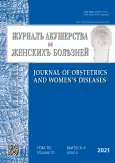伴有急性肠道感染的妇女在妊娠损伤期的分娩流量
- 作者: Kovalchuk A.S.1, Popov E.N.2, Lioznov D.A.3,4, Sudakov D.S.5,6
-
隶属关系:
- Clinical Infectious Hospital named after S.P. Botkin
- AVA-PETER Ltd.
- Smorodintsev Research Institute of Influenza
- the First Pavlov State Medical University of St. Petersburg
- North-Western State Medical University named after I.I. Mechnikov
- The Research Institute of Obstetrics, Gynecology, and Reproductology named after D.O. Ott
- 期: 卷 70, 编号 4 (2021)
- 页面: 57-63
- 栏目: Original study articles
- URL: https://bakhtiniada.ru/jowd/article/view/64875
- DOI: https://doi.org/10.17816/JOWD64875
- ID: 64875
如何引用文章
详细
论证:文献中关于患有急性肠道感染的妇女的产流数据极为罕见。这项最重要的妊娠期完成实习是专门针对单个工作和文章的。急性肠道感染患者尚未开发具体的靶向策略,产科医生必须由普遍接受的进行出生标准,而不清楚地了解了对急性肠道感染背景发生的分娩中并发症的性质。
目标是在怀孕期限下评估患有急性肠道感染的女性的妇女流动。
材料与方法。19岁至39岁的102名患者调查。在2017-2019在Clinical Infectious Disease Hospital named after S.P. Botkin出生。主要集团达到60名女神,他确定了急性肠道感染。比较组达到60名有条件 健康的女性。估计孕妇病原体急性肠道感染的谱,出生流程,在通用行为和新生儿状态期间的并发症。
结果。两组患者在分娩持续时间和无水间隔、一般活动异常出现频率、失血量、产妇受伤频率和产后并发症方面没有差异。主要人群中,早产口腔流感、急性和慢性胎儿缺氧、会阴切开术的发生率较高。 出生后第一分钟的窒息在患有急性肠道感染的妇女的新生儿中也更为常见。
结论。急性肠道感染可能使流速复杂化。对于患有急性肠道感染的妇女,有必要在常规分娩期间持续控制胎儿的状态,并确保及时对新生儿进行医疗护理。
作者简介
Alexey Kovalchuk
Clinical Infectious Hospital named after S.P. Botkin
Email: babai_jo@bk.ru
ORCID iD: 0000-0001-8206-6561
SPIN 代码: 2784-3503
MD, obstetrician-gynecologist
俄罗斯联邦, 195067, Saint-Petersburg, Piskarevsky avenue 49Eduard Popov
AVA-PETER Ltd.
Email: edwardpopov@mail.ru
ORCID iD: 0000-0001-8671-3551
Researcher ID: K-2802-2018
MD, Dr. Sci. (Med.), Assistant Professor, Head of the Department of Operative Gynecology
俄罗斯联邦, 191014, Saint-Petersburg, 55a, letter A, office. 3-N, 31Dmitry Lioznov
Smorodintsev Research Institute of Influenza; the First Pavlov State Medical University of St. Petersburg
Email: dlioznov@yandex.ru
ORCID iD: 0000-0003-3643-7354
SPIN 代码: 3321-6532
MD, Dr. Sci. (Med.), Professor
俄罗斯联邦, 197022, St. Petersburg, Professor Popov Street, 15/17; 41 Kirochnaya Str., Saint Petersburg, 191015Dmitry Sudakov
North-Western State Medical University named after I.I. Mechnikov; The Research Institute of Obstetrics, Gynecology, and Reproductology named after D.O. Ott
编辑信件的主要联系方式.
Email: suddakovv@yandex.ru
ORCID iD: 0000-0002-5270-0397
SPIN 代码: 6189-8705
MD, Cand. Sci. (Med.), Assistant of the Department of Obstetrics and Gynecology of the University, Head of the Educational and Methodological Department of the Research Institute
俄罗斯联邦, 41 Kirochnaya Str., Saint Petersburg, 191015; 3 Mendeleevskaya Line, Saint Petersburg, 199034参考
- Petersen E. Infections in obstetrics and gynecology: Textbook and atlas. New York: Thieme; 2006.
- Pfaff NF, Tillett J. Listeriosis and toxoplasmosis in pregnancy: Essentials for healthcare providers. J Perinat Neonatal Nurs. 2016;30(2):131–138. doi: 10.1097/JPN.0000000000000164
- Steinkraus GE, Wright BD. Septic abortion with intact fetal membranes caused by Campylobacter fetus subsp. fetus. J Clin Microbiol. 1994;32(6):1608–1609. doi: 10.1128/JCM.32.6.1608-1609.1994
- Sauerwein RW, Bisseling J, Horrevorts AM. Septic abortion associated with Campylobacter fetus subspecies fetus infection: case report and review of the literature. Infection. 1993; 21(5):331–333. doi: 10.1007/BF01712458
- O’Sullivan AM, Doré CJ, Coid CR. Campylobacters and impaired fetal development in mice. J Med Microbiol. 1988;25(1):7–12. doi: 10.1099/00222615-25-1-7
- Denton KJ, Clarke T. Role of Campylobacter jejuni as a placental pathogen. J Clin Pathol. 1992;45(2):171–172. doi: 10.1136/jcp.45.2.171
- Coughlin L, McGuigan J. Salmonella sepsis and miscarriage. Clin Microbiol Infect. 2003;9(8):2–4. doi: 10.1046/j.1469-0691.2003.00605.x
- Klooster JM, van der Roelofs HJ. Management of Salmonella infections during pregnancy and puerperium. N Engl J Med. 1997;51(2):83–86. doi: 10.1016/s0300-2977(97)00037-5
- Seoud M, Saade G, Uwaydah M, Azoury R. Typhoid fever in pregnancy. Obstet Gynecol. 1988;71(5):711–714.
- Rebarber A, Star Hampton B, Lewis V, Bender S. Shigellosis complicating preterm premature rupture of membranes resulting in congenital infection and preterm delivery. Obstet Gynecol. 2002;100(5 Pt 2):1063–1065. doi: 10.1016/s0029-7844(02)01992-0
- Parisot M, Jolivet A, Boukhari R, Carles G. Shigellosis and pregnancy in french guiana: Obstetric and neonatal complications. Am J Trop Med Hyg. 2016;95(1):26–30. doi: 10.4269/ajtmh.15-0669
- Markham KB, Backes Jr C, Samuels P. Bacteremia and intrauterine infection with Shigella sonnei in a pregnant woman with AIDS. Arch Gynecol Obstet. 2012;286(3):799–801. doi: 10.1007/s00404-012-2310-x
- Mor G, Cardenas I. The immune system in pregnancy: a unique complexity. Am J Reprod Immunol. 2010;63(6):425–433. doi: 10.1111/j.1600-0897.2010.00836.x
- Flamm G. Prenatalnie infectsii cheloveka: perevod c nemeckogo. Moscow: Medgiz; 1962. (In Russ.)
- Scialli AR, Rarick TL. Salmonella sepsis and second-trimester pregnancy loss. Obstet Gynecol. 1992;79(5 Pt 2):820–821.
- Mohanty S, Gaind R, Sehgal R, et al. Neonatal sepsis due to Salmonella typhi and paratyphi A. J Infect Dev Ctries. 2009;3(8):633–638. doi: 10.3855/jidc.557
- Belyaeva TV. Ostraya dizenteriya Fleksnera y genschin reproductivnogo vozrasta (clinica, epidemiologiya, immunologiya). [dissertation abstract]. Saint Petersburg; 1995. (In Russ.)
- Cherkasova NS. Nekotorye dannye k voprosu o dizenterii u beremennyh, rodil’nic i detej. In: 16-aja nauchnaja konferencija Rjazanskogo medicinskogo instituta: tezisy dokladov. Rjazan’; 1955. P. 155–159 (In Russ.)
- Makhmudova M. Osobennosti techeniya beremennosti i rodov bolnih bakterialnoi dizenteriei. Obstetrics and Gynecology. 1975;(7):67–68. (In Russ.)
补充文件






